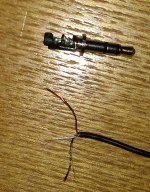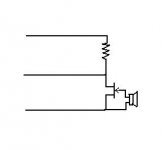That looks to me like a 3.5mm plug, and it is what we call a "TRS" type. TRS means tip-ring-sleeve. A plain old guitar cord would just be a TS for tip-sleeve. The tip is the little knob on the end. The ring is that extra metal band just behind the tip. And the sleeve is the barrel or body of the plug.
3.5mm is a standard size, often used for small headphones. 3.5mm is the diameter of the plug sleeve/shaft. There are also smaller ones like 2.5mm. If in doubt, either measure them with a little ruler, or take it to Radio Shack and compare to what is hanging on their wall. If you are not in the USA, then someone else may suggest store names to you.
SOme people refer to TRS plugs as "stereo" plugs. People like Radio Shack.
One thing I cannot tell you is which wire goes to which terminal in the plug.
3.5mm is a standard size, often used for small headphones. 3.5mm is the diameter of the plug sleeve/shaft. There are also smaller ones like 2.5mm. If in doubt, either measure them with a little ruler, or take it to Radio Shack and compare to what is hanging on their wall. If you are not in the USA, then someone else may suggest store names to you.
SOme people refer to TRS plugs as "stereo" plugs. People like Radio Shack.
One thing I cannot tell you is which wire goes to which terminal in the plug.
That looks to me like a 3.5mm plug, and it is what we call a "TRS" type. TRS means tip-ring-sleeve. A plain old guitar cord would just be a TS for tip-sleeve. The tip is the little knob on the end. The ring is that extra metal band just behind the tip. And the sleeve is the barrel or body of the plug.
3.5mm is a standard size, often used for small headphones. 3.5mm is the diameter of the plug sleeve/shaft. There are also smaller ones like 2.5mm. If in doubt, either measure them with a little ruler, or take it to Radio Shack and compare to what is hanging on their wall. If you are not in the USA, then someone else may suggest store names to you.
SOme people refer to TRS plugs as "stereo" plugs. People like Radio Shack.
One thing I cannot tell you is which wire goes to which terminal in the plug.
Thank you, now I know what plug to buy but no clue as to where the wires would go. Thanks again for your reply buddy.
Put the headphones on.
Plug in the connector to a sound source.
The sleeve is the connection that also clamps the whole cable. That is common to both the right and left channels.
I looks like there are red, white and some stranded wires. Difficult to tell.
IF this is the case:
Connect the stranded wires to the sleeve connecting point.
Take the red wire and touch it to one of the other connections (tip or ring) and check if the music is heard in the correct side (left or right). Write that down.
Take the white wire and touch it to one of the other connections (tip or ring) and check if the music is heard in the correct side (left or right). Write that down.
If you heard music on both channels for these two tests, then this presumption is incorrect.
If the red and white are just cable strengthening fibers then the stranded wires are the three you need to work with.
Use the same process...pick one for common (sleeve) and do the same test.
if you hear music on both sides then the wire you selected is not the common one...pick a different one and start over.
Eventually you will have a list:
Left side: xxx wire
right side: yyy wire
common: zzz wire
tip connects to left
ring goes to right
common connects to sleeve
When soldering these connectors, be very fast as some are made of easily melted plastic. This might be why some are sold in packs of two.
Hope that helps.
Plug in the connector to a sound source.
The sleeve is the connection that also clamps the whole cable. That is common to both the right and left channels.
I looks like there are red, white and some stranded wires. Difficult to tell.
IF this is the case:
Connect the stranded wires to the sleeve connecting point.
Take the red wire and touch it to one of the other connections (tip or ring) and check if the music is heard in the correct side (left or right). Write that down.
Take the white wire and touch it to one of the other connections (tip or ring) and check if the music is heard in the correct side (left or right). Write that down.
If you heard music on both channels for these two tests, then this presumption is incorrect.
If the red and white are just cable strengthening fibers then the stranded wires are the three you need to work with.
Use the same process...pick one for common (sleeve) and do the same test.
if you hear music on both sides then the wire you selected is not the common one...pick a different one and start over.
Eventually you will have a list:
Left side: xxx wire
right side: yyy wire
common: zzz wire
tip connects to left
ring goes to right
common connects to sleeve
When soldering these connectors, be very fast as some are made of easily melted plastic. This might be why some are sold in packs of two.
Hope that helps.
Put the headphones on.
Plug in the connector to a sound source.
The sleeve is the connection that also clamps the whole cable. That is common to both the right and left channels.
I looks like there are red, white and some stranded wires. Difficult to tell.
IF this is the case:
Connect the stranded wires to the sleeve connecting point.
Take the red wire and touch it to one of the other connections (tip or ring) and check if the music is heard in the correct side (left or right). Write that down.
Take the white wire and touch it to one of the other connections (tip or ring) and check if the music is heard in the correct side (left or right). Write that down.
If you heard music on both channels for these two tests, then this presumption is incorrect.
If the red and white are just cable strengthening fibers then the stranded wires are the three you need to work with.
Use the same process...pick one for common (sleeve) and do the same test.
if you hear music on both sides then the wire you selected is not the common one...pick a different one and start over.
Eventually you will have a list:
Left side: xxx wire
right side: yyy wire
common: zzz wire
tip connects to left
ring goes to right
common connects to sleeve
When soldering these connectors, be very fast as some are made of easily melted plastic. This might be why some are sold in packs of two.
Hope that helps.
Hi Dug, thanks for the reply, but this is for the microphone jack. As far as I can tell, its mono.(As mics are?)
We can likely assume the sleeve is ground/common.
If I had to do this from scratrch, as you are doing, I'd push the bare plug into the jack on the equipment and power up. See if there is any DC voltage on the tip or ring contact. I am wagering that your mic is an electret and needs an operating voltage, so one contact - probably tip if I had to guess - would carry signal, and the other - ring? - would carry that supply voltage.
But there are also mic arrangements that combine power and signal. Since we do not know what eqquipment this works with... SOme inexpensive recorders have a mic with a record switch on the mic. In those cases, I'd bet on the signal line as one and the switch the other of tip and ring.
If your mic has a switch, it should be simple to determine which wires are involved with that.
In the switched mic cases, the mic could be electre3t, but could also be just a cheap piezo crystal mic, needing no power supply. A small dynamic mic would need no power as well, but I'd think it less likely to be one than the others.
If I had to do this from scratrch, as you are doing, I'd push the bare plug into the jack on the equipment and power up. See if there is any DC voltage on the tip or ring contact. I am wagering that your mic is an electret and needs an operating voltage, so one contact - probably tip if I had to guess - would carry signal, and the other - ring? - would carry that supply voltage.
But there are also mic arrangements that combine power and signal. Since we do not know what eqquipment this works with... SOme inexpensive recorders have a mic with a record switch on the mic. In those cases, I'd bet on the signal line as one and the switch the other of tip and ring.
If your mic has a switch, it should be simple to determine which wires are involved with that.
In the switched mic cases, the mic could be electre3t, but could also be just a cheap piezo crystal mic, needing no power supply. A small dynamic mic would need no power as well, but I'd think it less likely to be one than the others.
Sorry, I missed the microphone part.
In that case it may be like the .jpg (or not)
Use an ohmmeter to find which wire is which.
I searched in Google images for "computer microphone pinout" and found a few different possibilities.
Which one applies will depend on what the results of the ohmmeter give you.
Sorry I can't help more.
In that case it may be like the .jpg (or not)
Use an ohmmeter to find which wire is which.
I searched in Google images for "computer microphone pinout" and found a few different possibilities.
Which one applies will depend on what the results of the ohmmeter give you.
Sorry I can't help more.
Attachments
What kind of headset mic is it? I have some diagrams if its a major brand as mics go.
Its a normal gaming headset mic.
"MODECOM MC-826"
- Status
- This old topic is closed. If you want to reopen this topic, contact a moderator using the "Report Post" button.
- Home
- Design & Build
- Construction Tips
- Fixing Microphone Jack Help

